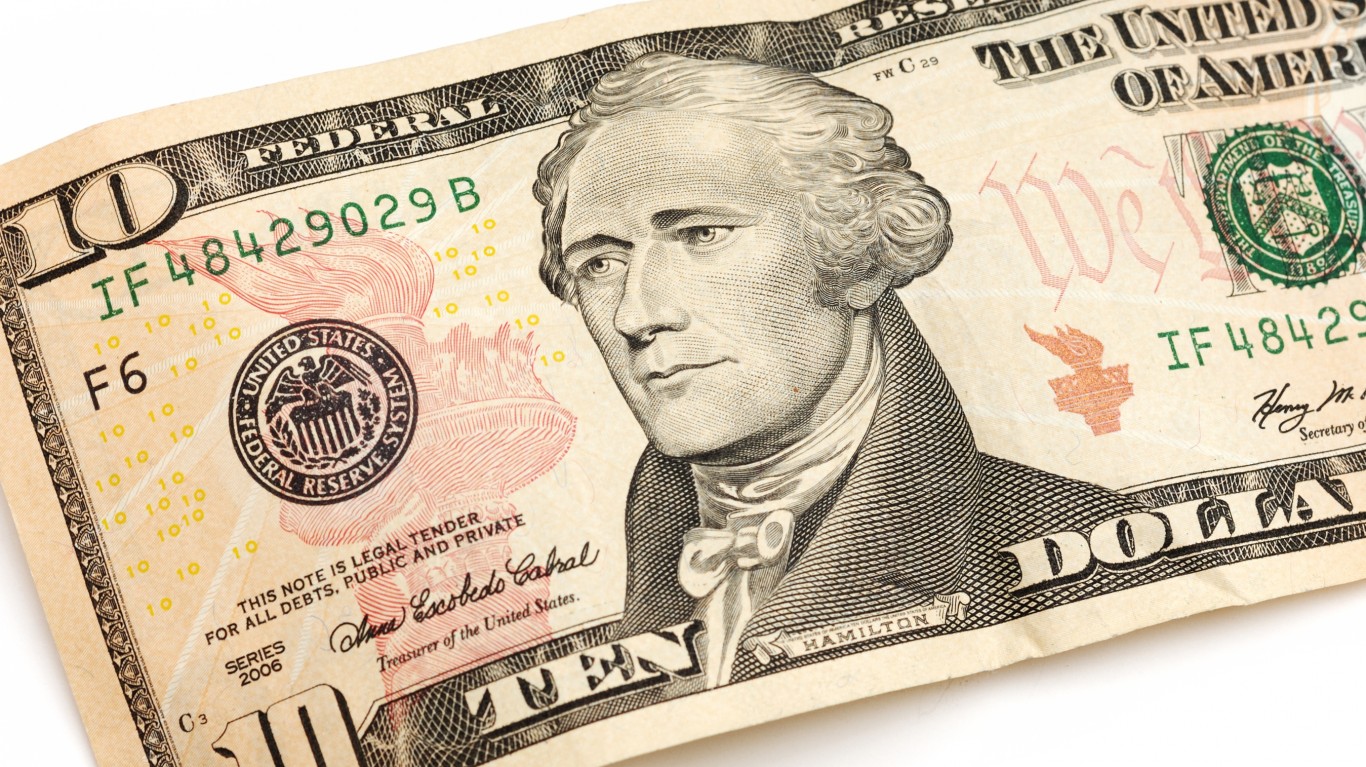

Now that 2019 has turned into 2020, it’s important to reflect on the great stock market gains of 2019. It is even more important to try to figure out where the markets will be heading in 2020, now that the bull market is well over 10 years old and stocks are at all-time highs. The Dow Jones industrial average rose by 22.3% to 28,538.44 last year, after closing 2018 at just 23,327.46. The S&P 500 closed out 2019 at 3,230.78, for a 28.9% gain from the 2,506.85 end of 2018, and the tech-heavy Nasdaq Composite Index rose by 35.2% to 8,972.60 from the 6,635.28 close of 2018. To say the market was up huge would be an incredible understatement, but now is the time to look ahead and see how much, or if, those late-2019 gains robbed some or all the stock market’s upside for 2020.
24/7 Wall St. uses the end of each year and start of the new year to create forecasts for the year ahead. The 2019 Dow target of 28,000 was surpassed by more than 500 points, and at the start of 2019 sentiment was so bad that it was very difficult to believe the numbers. The start of 2019 adequately proved that the fears in late 2018 were overblown and then some. At the end of the day, using a model can shake off all off the noise of the present moment and give investors more insight into deciding whether its time to buy more, sell or just hold. That model continued to hold true even as the media was incorrectly predicting the dawn of a new recession in the summer of 2018.
As for 2020, there are some new risks at the same time that some of the risks of yesteryear are abating. Tensions with Iran and in the Middle East are coming at the same time that North Korea has become more vocal and antagonistic again. What is going on for the markets and the economy is that China trade tensions are lower, and China just introduced new unexpected stimulus. Europe appears to be avoiding a recession, the 3.5% unemployment rate is incredibly low, interest rates are expected to remain somewhat steady and inflation is expected to remain at or under the Federal Reserve’s 2% baseline target.
It turns out that the end of 2019 was the polar opposite of the start of 2019. The markets entered 2020 nearly in a state of euphoria after such strong year-end gains. The good news is that the model we have used year in and year out is again calling for gains in stocks. The bad news, albeit with some obvious wild cards, is that the market gains look much more tempered for what to expect from the Dow and S&P indexes in 2020. As of the first day of 2019, the average expected gain from Refinitiv’s consensus analyst targets of the 30 Dow stocks was a total return of about 7.4%. Of those projected gains, an average dividend yield of 2.6% implied that most stocks would rise only about 5%, without factoring in those dividend gains.
24/7 Wall St. always reminds readers that trusting a single analyst call, particularly when it comes to the most bullish or most bearish calls, is often not the right move for investors. What is of value is the so-called consensus because this aims to smooth out the good and bad, and it looks through the noise, hypes and concerns that may be present today by offering a one-year outlook. The “bull versus bear review” title also implies that there can be downside as well as upside.
One simple factor about not assuming that all of 2020’s potential gains were eaten up with a strong year-end gain in 2019 would be that the gains were far less if you went back to compare the 2019 year-end prices against the prior highs from before the fourth quarter of 2018. The S&P 500 index closed out 2019 only about 10.2% from that prior 2018 peak before the panic set in. Now the market is not seeming to be all that crazy after all.
Despite the bull market lasting so long, and despite the economic recovery being the longest of our lives, we have to look back at the entire move from before and after the Great Recession for some better reflection. The Dow’s 28,538 close of 2019 was up from a low of about 7,500 from the peak selling wave of March 2009, but the Dow closed up over 170% for the past decade. The Dow previously peaked at 14,000 back in late 2007, ahead of the Great recession, a level that was not recaptured until early in 2013. Looking at that metric, the Dow would be up “only” about 100% on a combined 13-plus year period, less than 8% per year and barely 6% on a cumulative recurring basis.
Before getting into a sector by sector review of the Dow and creating a forecast of less than 8% on a total return basis for 2020, let’s consider some wild cards. Energy has lagged and is now under secular threats from the so-called ESG (environmental, social and governance) investing. Financials may have gone too far ahead of themselves at the end of 2019. Boeing Co. (NYSE: BA), which has been the most important Dow stock by weighting (due to the Dow’s sole share price-weighting methodology) has been a huge lag and could go either way in 2020. Health care remains a top hot-button for politicians in a 2020 election year, and that could impact three Dow components directly. There are also some key restructurings that may even change the components that make up the Dow in 2020.
Even some slight surprises to the upside from four or five select stocks could greatly bolster the expected upside ahead. How the election will play into this seems to be a very binary event for the markets, and we cannot ignore the risks from the ongoing major divide that is in the country at this time. Still, if there are upside surprises from the four or five top Dow stocks, it could more than offset the entire influence of the bottom half of the index. Here is a review and preview of how the model for Dow Jones industrial average could point to a baseline expectation of 7.4% gains to 30,650 in 2020.
First and foremost, the absolute leadership and dominance of technology cannot and must not be ignored. Apple Inc. (NASDAQ: AAPL) led the Dow with a whopping 86% gain, but it ended 2019 above the consensus estimate, even if analysts have started catching up to raise their target prices at the start of 2020. That said, the most optimistic analyst right now was calling for 20% upside potential for Apple in 2020, based on the rise of services meeting that iPhone supercycle for the coming 5G phones. Microsoft Corp. (NASDAQ: MSFT) was the second-largest gainer in the Dow, higher by 55% in 2019. Many expect Microsoft to prevail over Amazon.com Inc. (NASDAQ: AMZN) in the $10 billion JEDI cloud contract, and the cloud remains an ever-growing source of revenue growth, along with Microsoft’s online Office suite and other offerings.
Apple and Microsoft ended 2019 with a combined market cap of close to $2.5 trillion, with Apple being about 8% large. Each alone accounted for 15% of the gains of the entire S&P 500 and accounted for roughly 1,300 points (some 25%) of the Dow’s 5,200-point gain.
Intel Corp. (NASDAQ: INTC) performed well in 2019, with a 27.5% return, but the respective gains of 10.7% for Cisco Systems Inc. (NASDAQ: CSCO) and gain of almost 18% for International Business Machines Corp. (NYSE: IBM) failed to enthuse most investors. Cisco may have China and a lack of growth opportunities in other emerging markets to blame for its underperformance, but IBM is in serious need of a new CEO to lead its strategic imperatives and to spur the growth after its major acquisition of Red Hat.
Boeing remains a total wild card for the Dow in 2020. It was a huge disappointment after the two deadly crashes grounded the entire 737 Max fleet and the problems are still not solved. Even after firing its CEO, Boeing somehow still managed a 1% gain in 2019. That said, it entered 2020 down about 27% from the 2019 peak of about $446. Until the 737 Max grounding has a path of resolution, recertification and rekindled interest, it’s hard to even bother debating the consensus price target of $366.40 and expected upside in this review. At Boeing’s peak earlier in 2019 and before the selling pressure, its shares had risen 270% from early 2016.
The Dow’s top losers of 2019 could provide some cushion and upside to the Dow’s projected 7.4% gain if they experience snapback upside recoveries in 2020. This would pertain to negative returns from the likes of Walgreens, Pfizer and 3M. Because the performance has suffered on top of already high dividends, all three of these Dow losers were confirmed in the Dogs of the Dow we previewed in December.
Walgreens Boots Alliance Inc. (NASDAQ: WBA) ended the year with a 13.7% loss, but a gain of 15% to 20% from its lows kept it from being far worse. After shares closed at nearly $59 at year-end, the consensus target price was actually still down at $57.11, so the analyst community may ratchet targets up, or the shares may just be trading at more than what Wall Street really sees as a fair value.
Pfizer Inc. (NYSE: PFE) closed out 2019 with a return of −10.2%, but at $39.18, its consensus target price of $41.91 from Refinitiv would imply a total return expectation of about 10.9% for 2020. More data has been offered below with the health care sector, but Pfizer’s implied upside in 2020 might have looked better if the shares had not gained more than 10.5% in the fourth quarter.
3M Co. (NYSE: MMM) may have seen fourth-quarter gains of over 11%, but its shares ended last year with a very disappointing −7.4% total return. Will trade tensions easing help 3M’s China sales, or will management be able to get to the bottom of its ongoing margin erosion issues? And can 3M get its investors away from the unusual environmental situation the company is in now.
McDonald’s Corp. (NYSE: MCD) managed to offer an 11.3% return for investors who held all through 2019, but its close at $197.61 was down 11% from its highs. Analysts are calling for a total return of 15.4% to $223.07, but after such a big drop it seems odd that this suddenly is expected to reach yet another new high above the prior $221.93. Can its new CEO work magic and keep returning capital as has been seen in recent years, or will wage pressures and the continued rise of populism put too much pressure on its costs above what it can pass on to consumers?
Energy, particularly within oil and gas, keeps disappointing and acts as a huge lag for index investors. The move into ESG is only growing, and many investors either do not want to or have become exclusively against owning oil and gas stocks, or anything with deep ties to carbon and pollution. It almost no longer matters if oil and gas stocks are worth just eight or 10 times earnings. If a growing pool of investors will not invest in their at any price, there is no reason they cannot trade down to five times earnings, even if no other fundamental changes are seen in the market or the economy.
Chevron Corp. (NYSE: CVX) managed to beat many oil and gas stocks with a 10% gain in 2019, but the mere 2.3% gain from larger rival Exxon Mobil Corp. (NYSE: XOM) was only positive because of its high dividend yield. Exxon’s year-end price of $69.78 comes with roughly a 5% dividend yield. The consensus target price of $78.47 would imply a total return opportunity of about 17.5%, but Merrill Lynch sees close to 50% in implied upside in 2020 to its price objective. Chevron is also expected to see upside of about 17.3% in 2020, if the consensus target price comes to pass. That said, there was some disappointment and concern that Exxon’s year-end update in the first two trading days of 2020 was acting as a potential guiding down of its earnings.
Most investors assume that for the stock market to rise there must be a strong participation from the financial sector. After all, a strong stock market and a good economy should boost the overall perceived value of money and finance. When it comes to JPMorgan Chase & Co. (NYSE: JPM), the defacto leader of the money center banks with close to a $450 billion market cap and the safest credit profile, analysts are concerned that its 43% gain in 2019 may have eaten into 2020’s upside. The consensus target price showed that analysts believe JPMorgan was nearly 8% overvalued at the start of 2020.
The often overlooked Dow stock of Travelers Companies Inc. (NYSE: TRV) showed only a 14.3% gain in 2019, and expectation of not even 6% for 2020. Goldman Sachs Group Inc. (NYSE: GS) recovered from much of its panic selling lows, but it’s 37.6% return in 2019 was followed with an expected return of just 8.6% for 2020. American Express Co. (NYSE: AXP) was up just over 30% in 2019, but it has an unexciting 1.4% dividend yield and analysts are looking for just 7.3% upside on average in 2020. Some analysts are calling for stronger participation by financials in 2020, but the start of the year was not showing that Wall Street was very enthusiastic about its own prospects this year.
Merck & Co. Inc. (NYSE: MRK) and UnitedHealth Group Inc. (NYSE: UNH) both face a potential binary event around the 2020 elections. The same is true for Pfizer, but Pfizer has a wild card of its own around a potential Alzheimer’s drug that remains questionable but still has perhaps the greatest chance of all major pharma companies to get the first mass-approval to treat the disease. UnitedHealth rose 18% in 2019, and the consensus was calling for another 7% gain in 2020. That seems hard to fathom if universal healthcare or “Medicare for All” becomes a reality.
Merck shares the risk of price controls along with Pfizer, although Pfizer seems to have stood out as the Big Pharma player with the biggest drug price hikes at the start of 2020. Johnson & Johnson (NYSE: JNJ) has risks tied to the opioid epidemic and to ongoing talcum powder cases, although these may be ongoing issues for years.
The Dow may see a continued “evolution” with some restructuring efforts within its 30 components. While it would be easy to jump around, mergers and reorganizations are going to come with questions about Dow Inc. (NYSE: DOW) and United Technologies Corp. (NYSE: UTX). And what if Walgreens does manage to get the go-private offer that had been rumored in the fourth quarter? That would make three of the 30 Dow stocks witnessing structural (or would-be structural) changes, and it’s impossible to know how the index treatment will be handled. Will they remain or will they be replaced?
There are four more important Dow stocks worth considering as well. Verizon Communications Inc. (NYSE: VZ) stands out with a 4% dividend yield, but Wall Street’s consensus of a 4.6% implied total return implies that almost all the 2020 gains will be from its dividend. What if Verizon switches places with AT&T and gets anywhere close to AT&T’s 37% gains seen in 2019 that was unexpected a year ago. Walt Disney Co. (NYSE: DIS) was seen generating a gain of 9.3% in 2020, with the combined media and Disney+ efforts, and that’s after a near 32% gain in 2019. Nike Inc. (NYSE: NKE) managed to gain over 36% in 2019, even with a low dividend yield of 1%, and Wall Street sees gains above 8% on average, with some calling for upside of 15% or more. Caterpillar Inc. (NYSE: CAT) managed to rise by 16.2% in 2019 despite all of the woes with China and other emerging markets, but Wall Street could be way behind the curve with a projected 0.9% return in 2020 if things continue to improve for it.
Walmart Inc. (NYSE: WMT) still can be a resilient threat and force against the growth and dominance of Amazon. With annual revenues of more than $500 billion, and expected to rise 2% this year and 3% next year, the Walton empire is not expected to give in to the rise of Amazon any time soon. That said, Costco and Target have posted impressive gains of their own at the same time that it’s getting ever harder to find the proper dirt and locations for many new Walmart stores in the United States.
While the 2020 baseline prediction calls for the Dow to generate returns of 7.4% to 30,650 in 2020, here are the very simple steps from the top six components by weighting that could take the Dow up over 10%, to perhaps even 12%, in 2020:
- Boeing (7.8% weighting) gets its 737 Max recertified with the FAA and international agencies and manages to keep its orders going.
- Apple (7.0% weighting) achieves its iPhone super-cycle, with the rise of Apple TV, apps and services, and the most bullish analyst has even laid out a path to a $400 blue-sky upside.
- UnitedHealth (6.8% weighting) loses the threat of Medicare for All and universal care for another four years.
- Goldman Sachs (5.5% weighting) manages to rekindle growth and grow Marcus and efforts to bringing in main Street clients.
- Home Depot (5.2% weighting) manages to hold its lead over rival Lowe’s and to grow revenues better than just the 2% in 2019 and 4% for 2020.
- And McDonald’s (4.8% weighting) just manages to retake its old high as analysts are currently predicting.
Investors need to understand that there is no preset golden rule of where stocks will go in 2020. Using this model has worked well for trying to look at a peak value rather than for a year-end target, but all models have imperfections and may not reflect some drastic unknown changes that await, and there are always some that come up.
Unlike in 2019, it looks as though 2020 is the year that dividends are expected to be a key component of total returns. Just about every Dow stock raises its dividends each year, and that is expected to be the case in 2020. Stronger dividends are meant to show strong confidence for years ahead through multiple business cycles, while weaker dividend growth (or no dividend growth) would likely be viewed with caution.
The top consensus estimates likely will change after the first earnings reports come in during January, and that will hone in a closer outlook into what lies ahead for 2020. We have already shown how upside in just six of the Dow stocks with a combined 41% weighting of the index might take it up to 10% or 12% in 2020, closer to Dow 31,500. There is also no reason that a rekindled global economy and a wind-down of many of the top tensions around the planet could add even more gains than were expected at the start of 2019.
Here is the table of all 30 Dow stocks for 2019 gains and the 2020 outlook at the start of the year.
| 2020 Dow Outlook | 2019 Close | 52-Week Range | 2020 Target | Est. Upside | Yield | Tot. Return Est. | 2019 Gain/Loss |
| 3M | $176.42 | $150.58 – $219.75 | $171.44 | −2.8% | 3.3% | 0.5% | −7.41% |
| American Express | $124.49 | $93.23 – $129.34 | $131.83 | 5.9% | 1.4% | 7.3% | 30.60% |
| Apple | $293.65 | $142.00 – $293.97 | $266.22 | −9.3% | 1.1% | −8.2% | 86.16% |
| Boeing | $325.76 | $309.40 – $446.01 | $366.40 | 12.5% | 2.5% | 15.0% | 1.01% |
| Caterpillar | $147.68 | $111.75 – $148.93 | $144.82 | −1.9% | 2.8% | 0.9% | 16.22% |
| Chevron | $120.51 | $107.10 – $127.34 | $136.48 | 13.3% | 4.0% | 17.3% | 10.77% |
| Cisco Systems | $47.96 | $40.96 – $58.26 | $52.40 | 9.3% | 2.9% | 12.2% | 10.69% |
| Coca-Cola | $55.35 | $44.42 – $55.92 | $58.76 | 6.2% | 2.9% | 9.1% | 16.90% |
| Dow | $54.73 | $40.44 – $60.52 | $55.90 | 2.1% | 5.1% | 7.2% | 9.90% |
| Exxon Mobil | $69.78 | $66.31 – $83.49 | $78.47 | 12.5% | 5.0% | 17.5% | 2.33% |
| Goldman Sachs | $229.93 | $163.35 – $232.21 | $244.73 | 6.4% | 2.2% | 8.6% | 37.64% |
| Home Depot | $218.38 | $168.21 – $239.31 | $233.28 | 6.8% | 2.5% | 9.3% | 27.10% |
| Intel | $59.85 | $42.86 – $60.48 | $56.72 | −5.2% | 2.1% | −3.1% | 27.53% |
| IBM | $134.04 | $111.69 – $152.95 | $148.30 | 10.6% | 4.9% | 15.5% | 17.92% |
| Johnson & Johnson | $145.87 | $125.00 – $147.84 | $154.24 | 5.7% | 2.6% | 8.3% | 13.03% |
| JPMorgan | $139.40 | $95.94 – $140.08 | $128.58 | −7.8% | 2.6% | −5.2% | 42.80% |
| McDonald’s | $197.61 | $173.41 – $221.93 | $223.07 | 12.9% | 2.5% | 15.4% | 11.29% |
| Merck | $90.95 | $72.05 – $92.64 | $97.94 | 7.7% | 2.7% | 10.4% | 19.03% |
| Microsoft | $157.70 | $97.20 – $159.55 | $163.63 | 3.8% | 1.3% | 5.1% | 55.26% |
| Nike | $101.31 | $71.21 – $101.79 | $108.98 | 7.6% | 1.0% | 8.6% | 36.65% |
| Pfizer | $39.18 | $33.97 – $44.56 | $41.91 | 7.0% | 3.9% | 10.9% | −10.24% |
| Procter & Gamble | $124.90 | $89.08 – $126.60 | $127.95 | 2.4% | 2.4% | 4.8% | 35.88% |
| Travelers | $136.95 | $115.06 – $155.09 | $141.29 | 3.2% | 2.4% | 5.6% | 14.36% |
| United Technologies | $149.76 | $103.23 – $151.07 | $160.71 | 7.3% | 2.0% | 9.3% | 40.65% |
| UnitedHealth | $293.98 | $208.07 – $300.00 | $310.32 | 5.6% | 1.5% | 7.1% | 18.01% |
| Verizon | $61.40 | $52.28 – $62.22 | $61.75 | 0.6% | 4.0% | 4.6% | 9.21% |
| Visa | $187.90 | $127.88 – $189.89 | $203.43 | 8.3% | 0.6% | 8.9% | 42.41% |
| Walgreens | $58.96 | $49.03 – $74.94 | $57.11 | −3.1% | 3.1% | 0.0% | −13.71% |
| Walmart | $118.84 | $91.64 – $125.38 | $130.41 | 9.7% | 1.8% | 11.5% | 27.58% |
| Walt Disney | $144.63 | $105.94 – $153.41 | $156.28 | 8.1% | 1.2% | 9.3% | 31.90% |
| AVERAGES | 4.8% | 2.6% | 7.4% | 22.05% |
Take This Retirement Quiz To Get Matched With An Advisor Now (Sponsored)
Are you ready for retirement? Planning for retirement can be overwhelming, that’s why it could be a good idea to speak to a fiduciary financial advisor about your goals today.
Start by taking this retirement quiz right here from SmartAsset that will match you with up to 3 financial advisors that serve your area and beyond in 5 minutes. Smart Asset is now matching over 50,000 people a month.
Click here now to get started.
Thank you for reading! Have some feedback for us?
Contact the 24/7 Wall St. editorial team.



